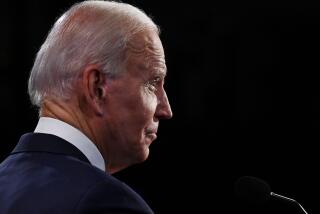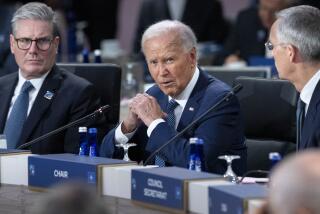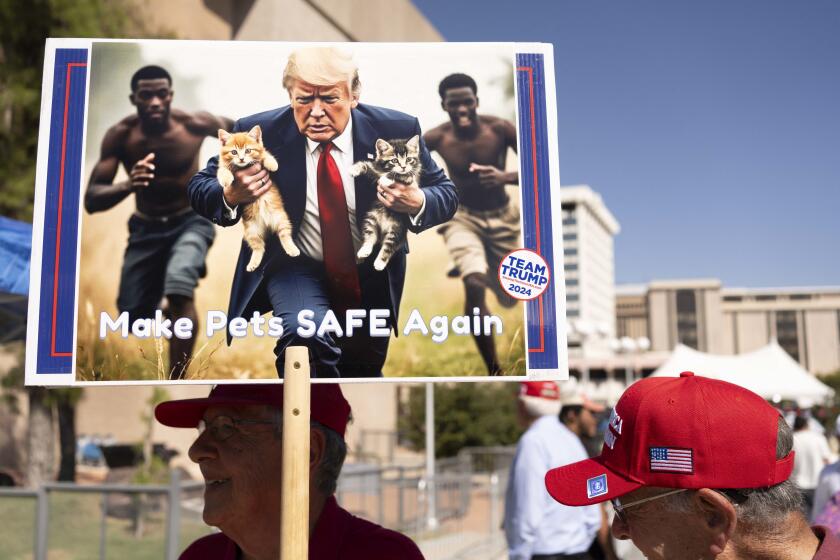Patt Morrison Asks: The brain, Alfredo Quinones-Hinojosa
Here’s a Hollywood pitch for you: Leading U.S. neurosurgeon started life as a struggling Mexican boy who made it from illegal-immigrant California farmworker to Harvard Med. Not buying it? You should. Dr. Alfredo Quiñones-Hinojosa was that kid and is that man -- associate prof, surgeon and head of the brain tumor stem cell lab at Johns Hopkins. His work puts him, passionately, on the cutting-edge of brain cancer research, and his life wedges him, reluctantly, into the immigration quarrel. He tells his story -- his traumas and triumphs, and his patients’ -- in an autobiography, “Becoming Dr. Q,” and here, now.
You started by working with your hands -- in cotton and tomato fields in California -- and here you are, still working with your hands as a brain surgeon.
I didn’t know I was going to be a brain surgeon, and yet I look back and don’t see how I could have done anything else. “Rocky IV” -- not my favorite movie but good -- when his wife tells him you can’t win: I was told that so many times. He turns around and says, “Even if I don’t win, I’m willing to give it all. They’re going to have to kill me to defeat me.” And I feel that in life. Working as a brain surgeon and scientist -- I was born to do this; all my life, I work with my hands, and here I am, full circle.
You “hopped the fence” for good in 1987. Before that I have to say that you were really lousy at jumping the border. You kept getting caught, forgot your work papers, couldn’t lie your way out of a paper bag.
I was terrible! But I just feel blessed that I was able to make it here. I love the United States; there is no country like America in the world. You can imagine how blessed I feel. In my office at Johns Hopkins, the No. 1 department of neurosurgery, I get patients from all over the world. It’s not something I take for granted, not at all.
Do people ask whether you know Dr. Greg House, the fictional TV diagnostic genius of Johns Hopkins?
It’s so funny you mention that. I’m training for a half-marathon [to benefit brain cancer patients]. I was cross-training on a machine and watching CNN and here he was, the actor. I didn’t realize he was from England, and he doesn’t have a limp! My wife loves the show; I hear about it from her.
Why did you wait so long to write a book about your story, to tell the world how you came to be here?
When “Hopkins” [a 2008 ABC TV documentary series about Johns Hopkins] was released, I realized I have been always afraid of being stigmatized, of people saying, “Oh, you became famous because of your story rather than your work.” I needed first to establish an incredible practice, one of the best brain tumor practices in the world. I needed to establish myself as a scientist. I needed to get federal funds to do research on brain tumors. I am the editor of the bible of brain surgery. I needed to accomplish all those things and then tell my story. That was a big deal for me. I’m just a regular guy. It took awhile to decide to tell the story the way I see it.
When you actually came out and said, “Yeah, I came here illegally” -- how hard was that?
The first time I said it in public was at lunch with my classmates in medical school in 1994. They asked me how I came to the United States, and I said I hopped the fence -- very matter of fact -- and everybody was laughing. Another of my classmates from Mexico, from a very distinguished family, was laughing too. I kept eating; I didn’t really know if I said something funny. I was still translating my lectures into Spanish, so I was learning the culture.
Then they realized I was serious. I began to realize, wow, this is not something trivial, this is something people pay attention to. At UC Berkeley, a tutor told me I couldn’t possibly be Mexican because I was too smart. I was intimidated. I was afraid at Harvard; every time I’d be in a situation where people noticed my accent, they were going to ask me where I was from.
So it took many years. When I was chosen by my classmates at Harvard to give the commencement speech, I had to reflect on that, and I said, “All right, this is who I am. It will start [as] a weakness; I can turn it into a strength.”
How did you legalize your status?
When I was in community college in Stockton, I had a work authorization, and that became a temporary green card. This was the time of the Ronald Reagan amnesty. I became a permanent resident the year that I started Berkeley, ‘91, and then a citizen in ’97 when I was at Harvard.
People advised you to change your name.
There are some things I feel very strongly about. When I was in the Castle Society at Harvard, friends argued how, for me to be successful, I should change my name to Al Quinn.
In ‘97, when I was going for citizenship, I realized, I’m not going to go the simple path. If I’m going to be successful in this country, I need to be proud of who I am and my roots.
So what do I do, instead of shortening my name? I hyphenate it to honor my mother. It became even longer and more challenging! When I was in [medical residency in] San Francisco, people started calling me Dr. Q. It’s a way for me to be connected to my patients and the people around me.
Why brain surgery, and brain cancer?
The brain symbolizes our world. The first time I saw that brain dancing in a patient, you realize this is the most beautiful organ in the body. When I open the brain, I can’t tell whether you’re Jewish, Christian, Muslim, black, white, Asian or Hispanic. And then, not only is the brain the most beautiful organ in our body, that allows us to be who we are, but [it] gets affected by the most devastating disease there is, which is brain cancer.
You felt pressured to go into primary care because the poor need care.
I think that [was] shortsighted. You can have influence by providing medical care to 100 people a year, or reaching millions of people through the kind of work that I’m doing now. There’s a need for both, but I felt my goal was to do research, and I fell in love with the brain and never abandoned those dreams.
A med school student told you the only reason you got into Harvard was because of quotas. You’ve been mistaken for a janitor. One patient didn’t want to be treated by a “dirty Mexican.” How did you handle all that?
You look at the blog [comments] when “Hopkins” came out -- and I’m sure you’re going to get it through your newspaper -- I can’t do anything about that. The beauty of the United States is that everybody is entitled to their opinion. And words can be hurtful sometimes. But this is what I’m doing for my country; this is what I’m doing for humanity. And maybe one day all those negative thinkers will change their minds. I have a very thick skin.
I had to think carefully before I told my story. But I think that’s what it takes to change the world.
Every day, when I leave the hospital and see people cleaning the floors and working in my office, I say thank you. Why? Because I’ve been on the other side. I was invisible. My parents are still invisible. When my mother had health problems, [she] told the doctor her son was a brain surgeon at Hopkins and the doctor laughed, literally.
Inevitably your story makes you a symbol for many immigration issues, like the DREAM Act.
I do recognize that, but I’m not here to talk about laws. I’m just a regular guy who has harnessed the power of the American dream, and I want people to think they can do it too. I can only tell you what I have done and what I do today. I get called all the time to come and talk about immigration, and I say, “Guys, I am a brain surgeon and scientist. I know nothing about immigration reform. I know nothing about laws; as a matter of fact, you don’t want me to spend my time learning about this.”
What’s the deepest mystery of the brain you’d like to solve?
I’d like to find the part of the brain that makes us love each other and eradicate the part of the brain that make us hate each other!
You’ll be in California in October to speak in Los Angeles and in the San Joaquin Valley. How do you feel, seeing fields like the ones you worked in?
I love the smell; it just brings me back to my roots. Even thinking about it, I get goose bumps. I’m sure [it] stimulates my limbic system! It reminds me of where I was just two decades ago and where I am today. It reminds me of the incredible human potential; I’m not just talking about myself, I’m talking about everyone who surrounds me, [people] struggling every day. It gives me the sense that together we can do it.
This interview is edited and excerpted from a longer taped transcript. An archive of past interviews is at latimes.com/pattasks.
More to Read
A cure for the common opinion
Get thought-provoking perspectives with our weekly newsletter.
You may occasionally receive promotional content from the Los Angeles Times.











